Joseph Keefe
-
- Engine Emissions: GE Changes the Conversation Maritime Logistics Professional, Q4 2014 #33
As operators ponder the thorny question of dual fuel, LNG or SCR Treatment, GE Transportation’s new medium speed marine diesel engine seemingly simplifies the playing field.
Current Events, Futuristic Propulsion
The October 2014 news that global oilfield giant Oceaneering had committed to building a ship designed with GE Transportation marine diesel engines was ordinary enough, but the recent keel laying ceremony held at the BAE Systems Shipyard in Mobile, AL held special significance for not only Oceaneeering, but for GE as well. That’s because the first ship to be outfitted with GE Transportation’s newest marine engine offering – ones which meet EPA Tier 4i and IMO Tier III Emissions standards – all without the need for a Selective Catalytic Reduction system (SCR) exhaust gas after-treatment, could change the way marine operators go about selecting their next set of engines for retrofit or new build.
The GE Marine 12V250 Marine diesel engines reduce NOx emissions by 70 percent when compared to EPA Tier 2 or IMO Tier II. Beyond this, GE Marine’s self-described ‘breakthrough’ engine technology not only eliminates the need for a Selective Catalytic Reduction system (SCR) exhaust gas after-treatment, but also the requirement to store or use urea aboard a vessel, thereby preserving cargo and tank space – not to mention all of the extra costs associated with that extraneous equipment.
Oceaneering specified five new GE Marine 12V250 Marine diesel engines to be integrated into gensets to power its new Inspection, Maintenance and Repair (IMR) vessel. GE Marine’s distributor, Cummins Mid-South, LLC, integrated the GE Marine 12V250 engines into the required gensets. The state-of-the–art vessel is expected to launch in early 2016.
Even before that, however, Harvey Gulf International Marine and Eastern Shipbuilding Group entered into a contract to construct a new Robert Allan, LTD. (RAL) RAmpage 6400 Multipurpose Field Support Vessel (MPFSV) at Eastern’s Panama City, Florida facilities. The MPFSV Hybrid designed vessel promises to provide better diesel fuel efficiencies than typical vessels of the same class during various offshore operating conditions. And, in this case, the vessel’s main engines call for two GE Marine 12V250MDC IMO II, EPA Tier 4i marine propulsion diesel engines. That’s important because Harvey Gulf, already the recognized North American leader in rolling out LNG and dual fuel propulsion vessels, in this case, selected a pure diesel engine. And, why not? An engine that meets EPA tier 4 requirements without the need for SCR after-treatment or urea injection arguably challenges the assumed supremacy of LNG as the fuel of choice for operators in a wide range and class of vessels.
Target Markets: Right on the Money
According to Rob Van Solingen, GE Transportation’s Senior Product Manager – Marine, one of GE’s markets for their new engine offering is the offshore oil and gas segment. “That includes PSVs, OSVs, offshore construction vessels, OCVs, IMR Inspection Maintenance and Repair vessels – all types of vessels that support the offshore oil and gas industry. They run on number two diesel fuel. No heavy fuel. And the power range they need is a perfect match to our GE medium-speed power range from 1,500 to 4,700 kW.” Other marine segments for the GE diesel engines include tugs and workboats, ATB’s, dredgers, ferries and inland waterways, to name a few. Engines are offered for direct mechanical propulsion or as gensets for diesel-electric propulsion.
GE Marine sets itself apart from its competitors, says Van Solingen, has to do with what emission path that GE selected, just a couple of years back. He explains, “We went to Tier 4 ‘intermediate’ a year earlier than other engine brands in the US. The difference being that we now still have a year of Tier 4 intermediate in 2015, before we go to Tier 4 final in 2016. The competition goes to Tier 4 final January of 2015”.
Building on their original V-250 line introduced in 2005, GE developed a new platform which allowed them to bring emission technology improvements on the engine. These include high pressure common rail fuel injection, two-stage turbocharging and EGR – exhaust gas recirculation. He continued, “And so, the result of an 8 year development program of diesel engine technology together with an upgraded control system, we maintain EPA T4 and IMO Tier III emissions within the engine.”
With their markets clearly defined, and because they spent all that money, GE will certainly want to make some (quick) returns in today’s markets. But, for many operators with existing tonnage, they won’t have to do anything at all until such time as they decide to either repower or replace those vessels. And, that could be a long time. That said, we asked Van Solingen just how wide his potential market could be. As it turns out; plenty wide.
“New vessel construction under EPA T4 time line needs to comply – as we see with the Oceaneering and Harvey Gulf vessels for our first customers. They could have selected a diesel engine with SCR exhaust after-treatment and urea, or as these customers did, select our engine and be free to carry more cargo or fuel,” explains Van Solingen, adding, “In addition, we see that there is a market overseas for IMO TIII despite this not coming into effect until 2016 and only in the NOx emission control areas. For example, countries like Norway already drive cleaner engines because vessel owners are being taxed on NOx. What we see is that pretty much all Offshore O&G support vessels built in Norway today are fitted with SCR systems or are otherwise operating cleaner than IMO Tier II emissions.”
Talking cost: today and tomorrow
Many operators talk a good “green game” but, in reality, most go green only when either (a.) forced to do so by regulatory pressures or (b.) the price is right and the move eventually impacts their bottom line in a positive fashion. The later scenario, though, is rarely the case. Consequently, just as the sticker shock of the new LNG / dual fuel propulsion arrangements give some players pause, the question of cost differential also has to be considered when considering GE’s new Tier 4 compliant solution versus its diesel competition. By some estimates, the cost of the dual fuel engines commonly being offered today – coupled with the expensive bunker tanks and delivery systems – exceeds an equivalent diesel arrangement by as much as 20 percent. Rob Van Solingen acknowledged – with caveats – that for GE’s newest engine, the same cost comparison also has to be made.
“Yes, there is a slight cost increase. This is represented by the additional equipment, the 2-stage turbo charging, and the exhaust gas recirculation, EGR, on the engine. But, when compared to what an SCR system and all its other related equipment – dosing system, monitoring systems, urea injection, and urea tanks – would cost, the difference is less. So CapEx is a little bit higher, but very much in line with what a similar engine system would cost with all the after treatment equipment included.”
Solingen then points out the advantages of his offering: “With the SCR equipped vessel, you have higher operating expense – injecting urea, exchanging the catalytic reactors – which you don’t have with our engines. So, the life cycle cost of the GE engine, as compared to an engine plus SCR system, is outstanding.”
SCR and urea, says Van Solingen, comes with its own considerable baggage: carrying it, injecting it, consuming it, having to clean the SCR system, the space it takes up. He adds, “You’re losing potential cargo and/or accommodation space over the life of the vessel. You have less fuel capacity, or need to add tanks, because now you need to carry 6 – 8 percent or more of your diesel fuel capacity in urea. All of that really starts to add up over the life of the vessel.”
Size Matters – for a number of reasons
According to Van Solingen, the real beauty of the engine itself rests in its size. The engine itself has grown a little in width (due primarily to the three turbo chargers); about one foot on either side. But, he adds, the length and height hasn’t changed appreciably. “It’s a very compact solution for our customers. The engine hasn’t grown by much, and they don’t need all the after-treatment equipment. The EGR system requires some extra engine cooling capacity, but as we’re dealing with ships, we haven’t seen any issue with having the vessels install a bit larger heat exchanging capacity.”
The engine is suitable for all manner of propulsion; standard propeller arrangements, Z drives, Voith Schneider systems, and diesel gensets for offshore electric vessels. And, for those owners looking to repower, Van Solingen claims that it would be much easier to go with an engine that doesn’t need all the SCR equipment. He adds, “Especially on a repower, that vessel is not designed to have SCR systems installed, to have urea tanks, to have all that dosing equipment. So, on a repower, the GE Tier 4 engine is a much more elegant solution and likely the easiest way to comply.”
Looking beyond diesel and SCR, there is, of course, the latest White Knight in the form of LNG. Leaving the infrastructure and logistics question completely aside, the lure of LNG remains attractive to many workboat operators. But LNG carries its own considerable baggage which, beyond its initial hefty price tag, includes the sizable physical footprint of the bunker tanks and delivery systems. All of that – like SCR but only more so – says, Van Solingen, adds up to a loss of carrying capacity and deadweight.
Clean – and Economical, too
Even the ‘greenest’ ship in the world, if it’s a money-loser, is a dog and is not worth sending out to sea. The GE Tier 4 solution, sans SCR after treatment, is nominally a compact, clean, affordable and environmentally compliant engine package. But, fuel economy is still king in a market where freight and charter rates are still recovering, and recovering slowly, at that. Van Solingen, addressing the six hundred pound gorilla in the room head on, says, “If you look at how these emission rules have evolved from EPA Tier 1, the initial methods of reducing emissions was to retard timing on the engine. Your fuel consumption actually went up. So it was, in my mind, quite a contradiction. You want to be greener, but now you’re starting to use more fuel.”
That, says Van Solingen, obviously doesn’t work anymore in today’s emission levels, which is why the after treatment systems have come into play. He explains further, “In our case, and this goes back again to where I was saying we have a relatively new engine platform that still had sufficient growth capacity with regard to development of combustion space and such, an allowed us to put together the combination of building blocks with which we meet the emissions requirements.” One of those components, the high pressure common rail fuel injection, contributes to lower fuel consumption. And, while the EGR increases fuel consumption slightly, the two-stage turbo charging improves that metric.
Van Solingen insists, “Overall, our engineering teams have done a tremendous job developing this new engine to meet EPA T4 without SCR or urea after-treatment, while maintaining fuel consumption levels at neutral or, for certain duty cycles, better when compared against our Tier 2 or Tier 3 engines, that are class leading in fuel consumption. Reliability, ease of maintenance and low life cycle cost is what our customers expect from their diesel engines and why they select GE.
Consumption, Compliance & Convenience
Until just recently, the repower or rebuild quandary was largely a question of whether to go with diesel and SCR, dual fuel and/or pure gas engines. Operators tempted by the LNG route still must decide whether the present infrastructure – and that which is promised – will materialize and if so, will be adequate to their requirements. Beyond this is the question of whether an LNG or dual fuel engine will ultimately require SCR for Tier 4 final compliance in any event. For those who go the low sulphur diesel route, the answer was, until just recently, quite clear: eventually you’d need that SCR. And in the case of both LNG and SCR assisted diesel arrangements, operators were looking at large infrastructure installs and the potential loss of deadweight and/or capacity. Not so anymore, says GE.
Shipowners and operators want, above all, economy. But, they also want simplicity. GE Transportation and Rob Van Solingen are banking on the hunch that, faced with the choice of a simple, diesel fueled solution that includes no SCR hassles, and another which might involve infrastructure and equipment that involves loss of carry capacity, the likelihood of enduring the hassle of SCR treatments, the uncertainty of (LNG) fuel supplies and logistics and the hassle of carrying as many as two fuels on board, many will opt for the ‘easy’ button. Two of the biggest and most progressive offshore energy players in the game – Harvey Gulf (already heavily invested in the LNG propulsion game) and Oceaneering – seem to think so, too. It’s not a stretch to say that they may be right.
(As published in the 4Q 2014 edition of Maritime Professional - www.maritimeprofessional.com)
-
- Partnerships, Prodding Propel the Ballast Water Treatment Game Maritime Logistics Professional, Q4 2014 #36
As the regulators inch towards the finish line, stakeholders and industry players are not sitting on their hands. For the OEM sector, partnerships and strategic alliances are emerging in advance of global mandates to install the equipment. Ballast Water SITREP The International Maritime Organization (IMO)
-
- Just in Time: ABS Ballast Water Treatment Advisory Maritime Logistics Professional, Q4 2014 #42
ABS has updated its guidance for ballast water management (BWM) and launched a ballast water management system (BWMS) selection service for shipowners and operators. The third edition of the American Bureau of Shipping’s (ABS) Ballast Water Treatment Advisory brings vessel owners and operators up to speed
-
- Workboats: Communications is Key Operational Tech Marine News, Dec 2014 #6
As we close out yet another year, I am constantly amazed at how much things change on the waterfront and the boats that ply the adjacent waters. Similarly, I like to tell people that it was five years ago when, within a narrow six-month window, I purchased my first ‘smart phone,’ a vehicle with global
-
- Expanding Operations Demand Robust Fleet Management Solution Marine News, Dec 2014 #32
As technology needs penetrate the growing offshore sector, Harvey Gulf will depend on Advanced Logistics’ software to support its expanding fleet deployments. When offshore heavyweight Harvey Gulf International Marine deployed Advanced Logistics’ marine management system, SAMM, and preventative maintenance
-
- Making Money with Marine Monitoring Marine News, Dec 2014 #36
The myriad benefits of gplink are well documented. What you do with it is literally ‘your business.’ Remote Monitoring and Tracking company gplink bills itself as the most capable remote diagnostic tool available for high horsepower systems. In a nutshell, gplink monitors commercial vessels and equipment
-
- Glycerin Powers into the Propulsion Picture Marine News, Dec 2014 #44
Maine Maritime Academy Receives a $1.4 Million U.S. DOT Research Grant to Develop a Marine Engine Testing and Emissions Laboratory. The Marine Engine Testing and Emissions Laboratory (METEL) at Maine Maritime Academy (MMA) is working on several initiatives to implement viable emissions reduction technologies
-
- Marine News January 2015 - Editor's Note Marine News, Jan 2015 #6
Our annual Ferry and Passenger Vessel edition kicks off the New Year in high gear, even if oil prices aren’t necessarily following suit. As vessel operators – our ferry drivers included – celebrate lower bunker prices, another maritime subset frets over what might happen to the offshore service market if
-
- SUNY Maritime: Bridging the Competency Gap Marine News, Jan 2015 #44
, Vice President of Regulatory Affairs at Bouchard Transportation made the traditional ribbon cut, as Morton S. Bouchard, III, his two sons, US Congressman Joseph Crowley, RADM Michael Alfultis, USMS, Ph.D., President of SUNY Maritime and a host of industry executives and dignitaries looked on. The simulation
-
- ‘Securing’ the Inland Markets with Innovative Standardization Marine News, Jan 2015 #48
Patterson Manufacturing follows its substantial success in the barge winch markets with an equally impressive boat-to-barge coupling system. In 2008, Pittsburgh-based Patterson Manufacturing Company developed the YoYo Barge Winch, a revolutionary design that reflected a total re-thinking of the way
-
- Marine Casualties & Fast Ferry Follies Maritime Reporter, Jan 2015 #8
Passenger vessel safety isn’t just a third world problem. It’s a worthy challenge to take up in 2015 and at the same time, a completely sobering way to ring in the New Year. As the clock ticks down on yet another year, I couldn’t help but take note of the new cruise ship passenger drill requirements
-
- Beyond the Black Box Maritime Reporter, Jan 2015 #50
Using the VDR as the Ship’s Data Clearing House provides budget-minded operators with the means, the bandwidth and the economy to monitor critical systems. Go on: dip your toes in the big data water. Big Data. It’s all the rage across the full spectrum of the maritime world. Thousands
-
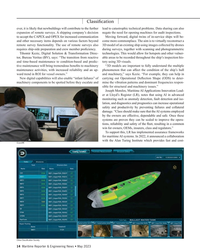 )
May 2023 - Maritime Reporter and Engineering News page: 14
)
May 2023 - Maritime Reporter and Engineering News page: 14components to be spotted before they escalate and mine the vibration patterns and dominant frequencies respon- sible for structural and machinery issues.” Joseph Morelos, Maritime AI Applications Innovation Lead- er at Lloyd’s Register (LR), notes that using AI in advanced monitoring such as anomaly detection
-
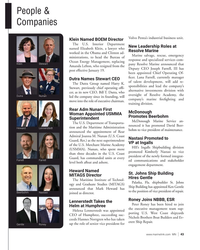 )
February 2023 - Marine News page: 43
)
February 2023 - Marine News page: 43services com- Ocean Energy Management, replacing Klein Stewart Amanda Lefton, who resigned from the pany Resolve Marine announced that Deputy CEO Joseph Farrell, III has post effective January 19. been appointed Chief Operating Of- ? cer. Lana Farrell, currently manager Dutra Names Stewart CEO The
-
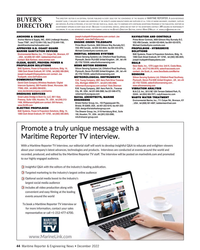 )
December 2022 - Maritime Reporter and Engineering News page: 44
)
December 2022 - Maritime Reporter and Engineering News page: 44IN THIS UYER S IRECTORY ECTION CONTACT ARK ALLEY AT MOMALLEY MARINELINK COM . I B ’ D S , M O’M @ . ANCHORS & CHAINS [email protected] contact: Joe NAVIGATION AND CONTROLS Hudspeth, www.GetToZero.com Anchor Marine & Supply, INC., 6545 Lindbergh Houston
-
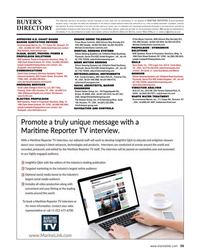 )
November 2022 - Maritime Reporter and Engineering News page: 59
)
November 2022 - Maritime Reporter and Engineering News page: 59Clark Street Endicott, NY 13760 , tel:(360) 306-2844, BAE Systems, Power & Propulsion Solutions, Bldg. 14, (0) 1752 723330, [email protected] [email protected] MEMS MOTION SENSING 1098 Clark Street Endicott, NY 13760 , tel:(360) 306-2844, SEALS Silicon Sensing Systems Ltd, Clittaford
-
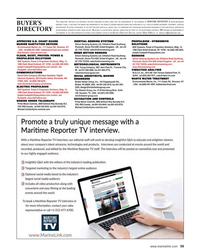 )
September 2022 - Maritime Reporter and Engineering News page: 59
)
September 2022 - Maritime Reporter and Engineering News page: 59(0) 1752 723330, [email protected] 1098 Clark Street Endicott, NY 13760 , tel:(360) 306-2844, Bob Kenison, www.envmar.com MEMS MOTION SENSING [email protected] CLEAN, QUIET, PROVEN: POWER & Silicon Sensing Systems Ltd, Clittaford Road Southway, SENSORS PROPULSION SOLUTIONS Plymouth
-
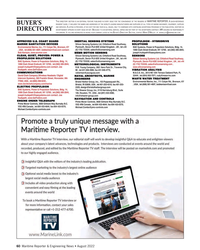 )
August 2022 - Maritime Reporter and Engineering News page: 60
)
August 2022 - Maritime Reporter and Engineering News page: 60(0) 1752 723330, [email protected] 1098 Clark Street Endicott, NY 13760 , tel:(360) 306-2844, Bob Kenison, www.envmar.com MEMS MOTION SENSING [email protected] CLEAN, QUIET, PROVEN: POWER & Silicon Sensing Systems Ltd, Clittaford Road Southway, SENSORS PROPULSION SOLUTIONS Plymouth
-
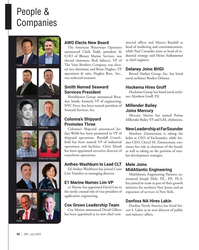 )
July 2022 - Marine News page: 41
)
July 2022 - Marine News page: 41Mele Joins Ed Anthes-Washburn has joined Coast MidAtlantic Engineering Line Transfers as managing director. MidAtlantic Engineering Partners an- nounced Joseph Mele, P.E., P.P., P.L.S. E1 Marine Names Lim VP has joined its team as part of their growth e1 Marine has appointed David Lim to initiative for
-
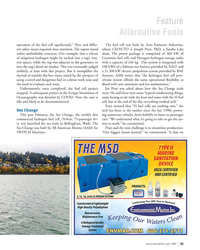 )
July 2022 - Marine News page: 34
)
July 2022 - Marine News page: 34.” New and differ- The fuel cell was built by Zero Emission Industries, ent safety issues required close attention. The report raised whose CEO/CTO is Joseph Pratt, PhD, a Sandia Labs rather unthinkable concerns. One example: that a release alum. The power package is comprised of 360 kW of of unignited
-
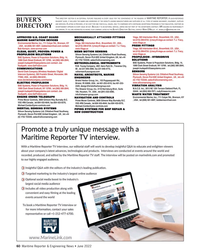 )
June 2022 - Maritime Reporter and Engineering News page: 60
)
June 2022 - Maritime Reporter and Engineering News page: 60Endicott, NY 13760 , tel:(360) 306-2844, (0) 1752 723330, [email protected] SOLUTIONS BAE Systems, Power & Propulsion Solutions, Bldg. 14, [email protected] contact: Joe METEOROLOGICAL INSTRUMENTS Hudspeth, www.GetToZero.com 1098 Clark Street Endicott, NY 13760 , tel:(360) 306-2844
-
 )
June 2022 - Maritime Reporter and Engineering News page: 56
)
June 2022 - Maritime Reporter and Engineering News page: 56left) during a military their EMC (Electromagnetic Compat- change-of-command ceremony presid- ibility) and Environmental Simulation ed over by President Joseph R. Biden Services (ESS) laboratories. The tour Jr. (above center) Wednesday, June was followed by a roundtable discus- 1, 2022, at Coast Guard Headquarte
-
 )
June 2022 - Maritime Reporter and Engineering News page: 45
)
June 2022 - Maritime Reporter and Engineering News page: 45perfect asset, the • Crew: 24 (Four of? cer; 20 enlisted) FRCs are the right asset for the job right now. “We’re making it work.” The crew of USCGC Joseph Gerczak (WPC 1126) prepare to moor at the port of Pago Pago, American Samoa, Aug. 3, 2019. They will conduct a joint ? sheries patrol with NOAA
-
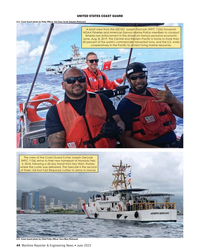 )
June 2022 - Maritime Reporter and Engineering News page: 44
)
June 2022 - Maritime Reporter and Engineering News page: 44UNITED STATES COAST GUARD U.S. Coast Guard photo by Petty Of? cer 3rd Class Scott Sabatini/Released A boat crew from the USCGC Joseph Gerczak (WPC 1126) transports NOAA Fisheries and American Samoa Marine Police members to conduct ? sheries law enforcement in the American Samoa exclusive economic zone
-
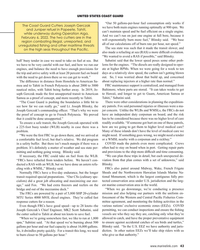 )
June 2022 - Maritime Reporter and Engineering News page: 43
)
June 2022 - Maritime Reporter and Engineering News page: 43UNITED STATES COAST GUARD “Our 50 gallons-per-hour fuel consumption only works if The Coast Guard Cutters Joseph Gerczak we have both main engines running optimally at 900 rpm. We and Juniper refuel in Papeete, Tahiti, can’t maintain speed and be fuel ef? cient on a single engine. while underway
-
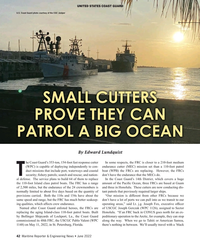 )
June 2022 - Maritime Reporter and Engineering News page: 42
)
June 2022 - Maritime Reporter and Engineering News page: 42seakeep- don’t have a lot of ports we can pull into as we transit to our ing qualities, which affects crew endurance. operating areas,” said Lt. j.g. Joseph Fox, executive of? cer Named after Coast Guard enlisted heroes, the FRCs are of USCGC Joseph Gerczak (WPC 1126), assigned to Sector replacing the
-
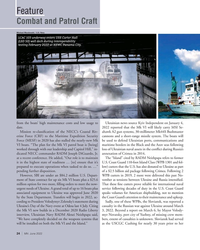 )
June 2022 - Marine News page: 24
)
June 2022 - Marine News page: 24worked through with our leadership and Capitol Hill,” in- loss of Ukrainian naval assets in the con? ict during Russia’s dicated NECC commander RADM Joseph DiGuardo, Jr. annexation of Crimea in 2014. at a recent conference. He added, “Our role is to maintain The “Island” cited by RADM Neizhpapa refers
-
 )
May 2022 - Maritime Reporter and Engineering News page: 59
)
May 2022 - Maritime Reporter and Engineering News page: 59Endicott, NY 13760 , tel:(360) 306-2844, (0) 1752 723330, [email protected] SOLUTIONS BAE Systems, Power & Propulsion Solutions, Bldg. 14, [email protected] contact: Joe METEOROLOGICAL INSTRUMENTS Hudspeth, www.GetToZero.com 1098 Clark Street Endicott, NY 13760 , tel:(360) 306-2844
-
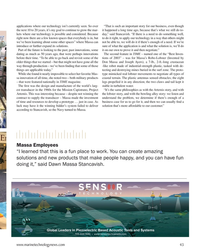 )
May 2022 - Marine Technology Reporter page: 43
)
May 2022 - Marine Technology Reporter page: 43some of the tions of 2003” – was for Massa’s Robo-Lobster (Invented by older things that we started – but that might not have gone all the Don Massa and Joseph Ayers), a 7-lb., 2-ft.-long crustacean way through production – we’ve been ? nding that some of those -like robot made of industrial-strength plastic
-
 )
April 2022 - Maritime Reporter and Engineering News page: 59
)
April 2022 - Maritime Reporter and Engineering News page: 59299-6724, [email protected] contact: T.J. Tracy, 1098 Clark Street Endicott, NY 13760 , tel:(360) 306-2844, MEMS MOTION SENSING www.Viega.us [email protected] contact: Joe Silicon Sensing Systems Ltd, Clittaford Road Southway, PROPULSION - HYBRIDRIVE Hudspeth, www.GetToZero.com
-
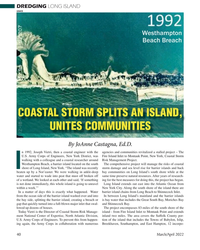 )
March 2022 - Marine Technology Reporter page: 40
)
March 2022 - Marine Technology Reporter page: 40DREDGING LONG ISLAND USACE Westhampton Beach Breach By JoAnne Castagna, Ed.D. n 1992, Joseph Vietri, then a coastal engineer with the agencies and communities revitalized a stalled project – The U.S. Army Corps of Engineers, New York District, was Fire Island Inlet to Montauk Point, New York, Coastal
-
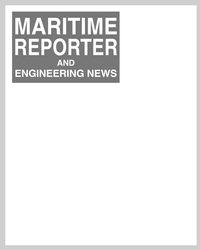 )
March 2022 - Maritime Reporter and Engineering News page: 40
)
March 2022 - Maritime Reporter and Engineering News page: 40DREDGING LONG ISLAND USACE Westhampton Beach Breach By JoAnne Castagna, Ed.D. n 1992, Joseph Vietri, then a coastal engineer with the agencies and communities revitalized a stalled project – The U.S. Army Corps of Engineers, New York District, was Fire Island Inlet to Montauk Point, New York, Coastal
-
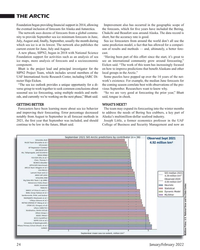 )
January 2022 - Marine Technology Reporter page: 24
)
January 2022 - Marine Technology Reporter page: 24to September in all forecast methods in Alaska’s multimillion-dollar seafood industry. 2021, the ? rst year that September was included, and should Joseph Little, a former economics professor in the UAF continue to be low in the future, Bhatt said. College of Business and Security Management and now
-
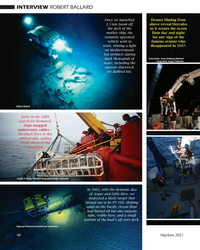 )
May 2021 - Marine Technology Reporter page: 40
)
May 2021 - Marine Technology Reporter page: 40in the 1989 search for Bismarck, Argo snagged underwater cables— the black lines in this photograph, adding to the stress of the expedition. Joseph H. Bailey/National Geographic Image Collection In 2002, with the dynamic duo of Argus and Little Herc, we inspected a likely target that turned
-
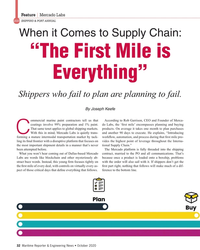 )
October 2020 - Maritime Reporter and Engineering News page: 32
)
October 2020 - Maritime Reporter and Engineering News page: 32Labs 2020 SHIPPING & PORT ANNUAL When it Comes to Supply Chain: “The First Mile is Everything” Shippers who fail to plan are planning to fail. By Joseph Keefe ommercial marine paint contractors tell us that According to Rob Garrison, CEO and Founder of Merca- coatings involve 99% preparation and 1% paint
-
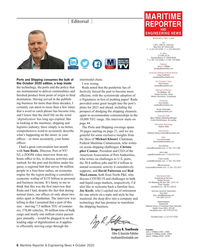 )
October 2020 - Maritime Reporter and Engineering News page: 6
)
October 2020 - Maritime Reporter and Engineering News page: 6MARITIME Editorial REPORTER AND ENGINEERING NEWS M A R I N E L I N K . C O M HQ 118 E. 25th St., 2nd Floor New York, NY 10010 USA T +1 212 477 6700; F +1 212 254 6271 FL Of? ce 215 NW 3rd St Boynton Beach, FL 33435-4009 T +1 561 732 4368; F +1 561 732 6984 Publisher John C. O’Malley @ShipNews jomalley@mar
